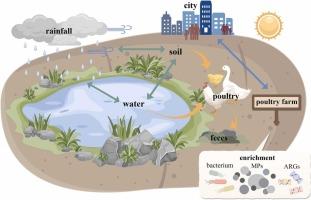Characteristics of microplastics in typical poultry farms and the association of environment microplastics colonized-microbiota, waterfowl gut microbiota, and antibiotic resistance genes
IF 11.3
1区 环境科学与生态学
Q1 ENGINEERING, ENVIRONMENTAL
引用次数: 0
Abstract
Microplastics (MPs) pollution is a growing global environmental concern. MPs serve as ecological niches for microbial communities, which may accelerate the spread of antibiotic resistance genes (ARGs), posing risks to the breeding industry. While studies on MPs in aquatic organisms are common, research on farmed poultry is limited. This study investigates MPs in poultry farm environments and waterfowl intestines for the first time. MPs were isolated via density separation and analyzed for characterization in soil, pond water, and waterfowl intestines. Metagenomics was used to investigate the association between environment MPs colonized-microbiota and waterfowl gut microbiota. Our findings reveal that MPs are abundant in soil (6.75 ± 2.78 items/g d.w.), pond water (0.94 ± 0.28 items/g w.w.), and poultry intestines (45.35 ± 19.52 items/g w.w.), primarily appearing as fragmented particles sized 20–50 μm. MPs abundance in intestines correlates with environmental levels. Colonized-microbiota on MPs are linked to poultry intestinal microbiota, with greater diversity and microbial functions. Network analysis reveals that Corynebacterium plays a key role in MPs and poultry intestinal. Polymyxin resistance exhibits high clustering. Procrustes analysis reveals correlations between MPs, bacteria, and ARGs in the farming environment. Overall, MPs in poultry farms may facilitate pathogen and ARGs transmission, posing risks to animal gut health.

典型家禽养殖场中微塑料的特征以及微塑料定植环境微生物群、水禽肠道微生物群和抗生素耐药性基因之间的关联
微塑料污染是一个日益严重的全球环境问题。MPs作为微生物群落的生态位,可能加速抗生素耐药基因(ARGs)的传播,给养殖业带来风险。虽然对水生生物中MPs的研究很常见,但对养殖家禽的研究却很有限。本研究首次对家禽养殖场环境和水禽肠道中的MPs进行了研究。采用密度分离法分离MPs,并在土壤、池塘水和水禽肠道中进行鉴定。采用宏基因组学方法研究了环境MPs定殖菌群与水禽肠道菌群的关系。结果表明,MPs在土壤(6.75±2.78项/g d.w.)、池塘水(0.94±0.28项/g w.w.)和家禽肠道(45.35±19.52项/g w.w.)中含量丰富,主要表现为20 ~ 50 μm的碎片状颗粒。肠道中MPs的丰度与环境水平相关。MPs上的定殖微生物群与家禽肠道微生物群有关,具有更大的多样性和微生物功能。网络分析表明,棒状杆菌在MPs和家禽肠道中起关键作用。多粘菌素耐药呈高聚集性。Procrustes分析揭示了农业环境中MPs、细菌和ARGs之间的相关性。总体而言,家禽养殖场中的MPs可能促进病原体和ARGs的传播,对动物肠道健康构成风险。
本文章由计算机程序翻译,如有差异,请以英文原文为准。
求助全文
约1分钟内获得全文
求助全文
来源期刊

Journal of Hazardous Materials
工程技术-工程:环境
CiteScore
25.40
自引率
5.90%
发文量
3059
审稿时长
58 days
期刊介绍:
The Journal of Hazardous Materials serves as a global platform for promoting cutting-edge research in the field of Environmental Science and Engineering. Our publication features a wide range of articles, including full-length research papers, review articles, and perspectives, with the aim of enhancing our understanding of the dangers and risks associated with various materials concerning public health and the environment. It is important to note that the term "environmental contaminants" refers specifically to substances that pose hazardous effects through contamination, while excluding those that do not have such impacts on the environment or human health. Moreover, we emphasize the distinction between wastes and hazardous materials in order to provide further clarity on the scope of the journal. We have a keen interest in exploring specific compounds and microbial agents that have adverse effects on the environment.
 求助内容:
求助内容: 应助结果提醒方式:
应助结果提醒方式:


